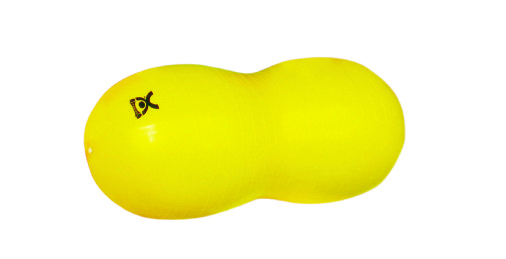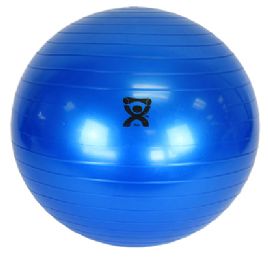



.jpg&newheight=260&quality=80)







What is a Therapy Ball?
A therapy ball, also known as an exercise or yoga ball, is a large inflatable ball that can be used in many ways. Some of these ways include yoga, physical therapy, and core strengthening exercises. Usually it is made of durable material such as polyvinyl chloride to withstand several hundred pounds of weight, and can be available in different sizes. This helps in choosing the proper diameter for different body sizes and types of exercise. The surface of a therapy ball is usually smooth but not slick so that skin and clothing can easily grip it, and prevent the ball from slipping out from under the user. When a ball is inflated to full capacity, it feels very firm and may be uncomfortable for some to sit, lie, or roll on. If this is the case, some experts suggest getting a size larger than needed so it can be under inflated to remain soft.
Learning how to sit on a therapy ball may take some time. First, it may be necessary to learn how to balance and stabilize the back for better balance. Sometimes it is a good idea to position the ball close to a wall so an individual can catch themselves while learning how to balance. Once balancing has been mastered, some often find the ball so comfortable that it is used in place of an office chair if a lot of sitting is required. Using a therapy ball provides support while still forcing the muscles to work to maintain balance. It also allows the user to isolate and train specific muscles in the core of the body.
Although the large therapy ball can be suitable for sitting, there are several smaller balls which can be used in therapeutic settings. Some are very small so they can be placed under a limb during a stretch, others are medium sized and used to increase flexibility and strength. Even a medicine ball is considered a therapy ball since it can be used to help improve or restore strength or function. Sometimes a physical therapist can help in deciding what type and size of ball is best for specific needs.
What is an Exercise Ball Chair?
An exercise ball chair is made of a large exercise ball and a chair frame which holds the ball in place. Many like an exercise ball chair in order to get the health and fitness benefits of sitting on one while enjoying the stability of a chair. According to some advocates, sitting on a ball can work the core abdominal muscles and reduce back pain. Besides providing stability, an exercise ball chair typically looks more professional than just sitting on an exercise ball. Therefore, offices may be more likely to allow workers to use this type of chair in the office.
When selecting this type of chair, pay attention to its height so it is not too close to the ground for use with a table or desk. Another item to consider is that the ball itself should be able to support the weight of the individual who will be sitting on it. Many exercise balls can support up to 600 pounds, but make sure the one included with the chair base is strong enough to meet the user’s needs.
What is a Medicine Ball?
A medicine ball is a weighted ball which can weigh anywhere from a couple of pounds up to 25 pounds. It can be used in rehabilitation or as part of an athletic training program to help recover from, or prevent, an injury. The weight of a medicine ball is important, unlike a standard air-filled ball. The extra weight can help take exercises to a higher level, and also to help absorb the impact if a ball is caught. Some assume the best medicine ball is the heaviest one that can be found. But, that is not always the case, especially if one is just beginning an exercise program. Most people normally begin with a lower weighted ball which is held while doing sit-ups, squats, or leg lifts, then increasing to heavier weighted balls. Using a ball that is too heavy can cause injury.
Heavier medicine balls do have their own function. When an athlete wants to train and use more force in throwing and kicking, a heavier ball absorbs a certain amount of the impact. This means an individual must work harder to get a heavier ball to go the distance. Over time, using a heavier medicine ball may increase the force that an athlete can kick or throw. For those who are not professional athletes, the weight of a medicine ball tends to not exceed about 8 pounds. This extra weight contributes to strength training and provides just enough to thoroughly work the muscles more during a variety of exercises. They can be used in various types of exercise methods, such as Pilates, some modernized forms of yoga, and aerobic classes like spinning or aerobic dance.
Lighter medicine balls can be used for athletes who have suffered an injury. They can be part of a group of exercises which are designed by physical therapists or sports medicine experts to help increase strength and maximize range of motion without risking injury. It is a good idea to get a specific recommendation from a physical therapist or trainer to be certain the correct weight and type of ball is chosen for the particular exercises that will be performed. Do not confuse medicine ball exercises with therapy ball exercises. They are both used in rehabilitation, but serve completely different purposes. Some exercises may combine the use of both types of balls, but do not substitute one for the other.
Rehabmart is proud to carry a comprehensive selection of therapy balls from high quality vendors, which include Enabling Devices, Ideal Products, Fabrication Enterprises, Health Mark Inc., North Coast, Sammons Preston, Exertools, Kaye Products Inc., Southpaw Enterprises, MaxiAids, J/Fit, Maddak, and others.
Mike Price, OT
Rehabmart Co-Founder & CTO
lb